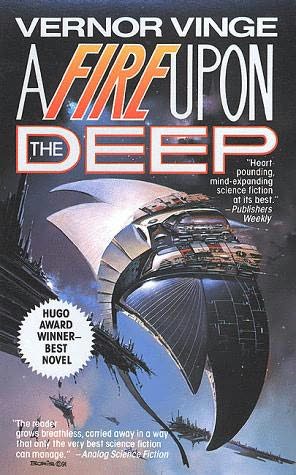Any one of the ideas in A Fire Upon the Deep would have kept an ordinary writer going for years. For me it’s the book that does everything right, the example of what science fiction does when it works.
There’s a universe where not only technology but the very ability to think increases with distance from the galactic core, and the universe is divided into “zones of thought.” In the “Slow Zone” you can’t have true AI or FTL. In the “Beyond” you can have those things, but nothing that takes more than human level intelligence. In the Transcend you have singularities and godlike beings, and above that, who knows? There’s an ancient godlike evil known as the Blight lurking at the edge of the Transcend, the level where it’s possible to become a Power. Humans poking around wake it up and trigger a catastrophe. Their escaping ship, which might contain the seeds of the Blight’s destruction, rushes to the bottom of the Beyond, where it lands on a planet where the inhabitants, the Tines, are pack minds, at a medieval tech level. Meanwhile, Ravna, a human librarian at Relay, and Pham, a human rescued from the Slowness and patched together by a Power, start a rescue mission.
You could have lots of great stories set in the Beyond, with its solar systems full of uneasily co-existing alien civilizations. You could have stories set in the Slowness—Vinge later outdid himself with one, A Deepness in the Sky. You could have long series of books set on the Tines world, especially about first contact with them when humans get there. The interstellar newsgroups could themselves have sustained trilogies. What Vinge gives us of his universe is like what Tolkien says of Middle Earth, “an account… of its end and passing away before its beginning and middle had been told.” A Fire Upon the Deep is the story of an absolutely fascinating universe and of how it came to an end.
The book alternates between the big events happening in space and the small events happening on Tines World. It never fails to leave one story at a point where you want more of it, and never fails to be enthralling with the other story. There are two stories on the planet—Jefri and Johanna are separated and dealing with two entirely opposed groups of aliens. Tines World has nations and climates and history and philosophies, as well as fascinatingly bizarre aliens. And for those aliens, the human language, Samnorsk, and human history and technology as revealed by the child’s toy dataset they have from the human children, is new and universe changing, while we know that humans are trivially unimportant in the larger scale of things and that Samnorsk is a minor unimportant language. There’s a good cognitive dissonance with that.
Vinge does really well at making the wider universe seem real, even though we don’t see all that much of it. We have what Ravna takes for granted, and what she has to explain to Pham. We see the newsgroups and get to know some of the posters—like the Aphranti Hegemony (“Death to Vermin”) and Sandor at the Zoo. We see a little of Relay and a little of Harmonious Repose, but it’s surprising how much detail is evoked with so little. The Beyond feels solid, with its layers of translation and weird aliens—ones that walk on tusks, and ones like potted plants, and Twirlip of the Mists, who sounds demented but is always right.
He does a lot with evocative names and casually mentioned references that get nailed down by being referenced from different directions—for example the planet from which humanity emerged from the Slowness, Njora, is mentioned in the context of the fairy tale “Age of Princesses” several times by the kids on Tines World comparing the Tines tech, and there’s a reference to the fountain flowing on Straum to say humanity would never forget its origins, not to mention the Straumli forests with mechanical copies of Njoran wildlife, and then on the ship (the Out of Band II, great name) when Pham makes the illusion of a castle Ravna thinks that in the Age of Princesses the castles were in tropical swamps so they didn’t have fireplaces. That’s just one tiny thing, but everything is as well sourced as this, and all the information is delicately inclued, dropped in smoothly. The details build up a picture that’s consistent and interesting, and some of the details are major clues you can’t recognise the first time through.
I read A Fire Upon the Deep from the library pretty much as soon as it was published in 1992. I was already looking out for Vinge; I’d enjoyed The Peace War and Marooned in Realtime a few years before, though I was very impressed with how much better this was. I bought the Millennium paperback I now own as soon as it came out in 1993. So I’d read it at least twice before I got online in May 1994. The thing about that was that when I saw usenet, I immediately recognised it from Vinge’s “Net of a million lies.” I can’t thank Vinge enough for educating me in how usenet worked so that I could plunge right in and not make too much of a fool of myself. It’s weird that blogs, which didn’t come along until much later, work like the net in Ender’s Game, which I first read on New Year’s Day 1985.
A Fire Upon the Deep remains a favourite and a delight to re-read, absorbing even when I know exactly what’s coming. Deepness is a better novel, but A Fire Upon the Deep is more fun.










